How to Spot and Prevent Dehydration in Dogs
Posted: 11/06/2023 | BY: Erin Cain | Categories: Uncategorized
Healthy dogs are susceptible to dehydration for several reasons. Heat exposure, exercise, and illness are the most common causes. Symptoms of dehydration in dogs include increased thirst, decreased urination, lethargy, panting, and vomiting. In extreme cases, dehydration leads to organ failure. It is essential to spot the signs of dehydration in your dog so that you can get them help if necessary. Let’s examine the causes and symptoms of dehydration in dogs and how to prevent it from happening.
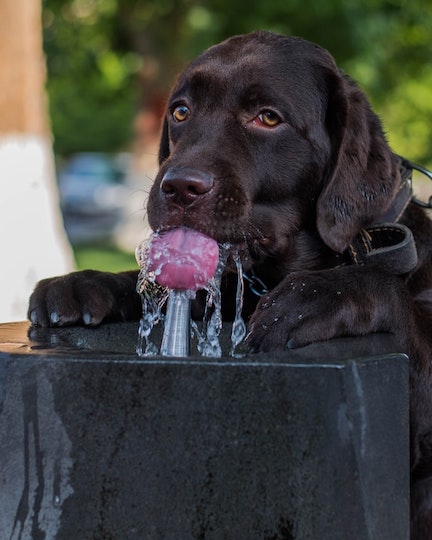
What is canine dehydration?
Just as people need water to stay healthy, so too do dogs. Water is necessary for all canine bodily functions, such as lubricating the joints, regulating body temperature, encouraging healthy digestion, and supporting internal organs. If your dog loses more water and electrolytes than they’re taking in, it leads to dehydration. Serious health problems can follow, such as weakness, loss of muscle function, loss of consciousness, and in the worst cases, kidney failure and kidney disease, and even death.
Your dog’s natural activities, such as breathing, panting, urinating, and defecating, can cause fluid loss throughout the day. Dogs also lose water that evaporates through the paws. When your dog eats or drinks anything containing water content, the lost electrolytes and water are replaced. Dehydration begins if the fluid intake becomes less than what the dog is losing. This condition causes the reduction in bodily fluids, which can lead to an organ or tissue being deprived of oxygen because there isn’t enough water for it anymore.
The canine body needs electrolytes to keep it running smoothly. Electrolytes are minerals necessary for healthy cells, such as sodium, chloride, and potassium. These minerals help move nutrients into cell walls and assist in muscle functions. Incredibly significantly, electrolytes regulate nerve function and activities, and body temperature. Without an adequate amount of electrolytes, the body begins to break down.
Dehydration in dogs is caused by many reasons, including illness, heat stroke, diabetes, diarrhea, fever, constant vomiting, and a lack of sufficient fluid intake. Senior dogs and puppies are especially at risk for dehydration and must be observed carefully for any changes in behavior.
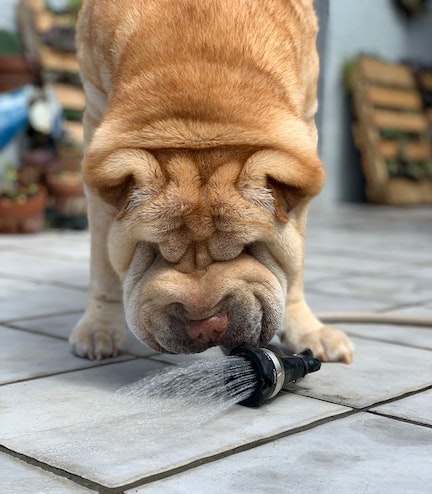
What are the symptoms of dehydration in dogs?
Dehydration is a medical condition in which your dog’s body has less fluid than it needs. Symptoms of dehydration can be seen in canines with as little as 5% fluid loss. Here are the most common signs of dehydration in dogs:
- dry nose
- thick saliva
- panting
- shivering
- loss of appetite
- lethargy
- persistent vomiting
- sunken eyes
- sticky, tacky, dry gums
- weakness and difficulty standing
- collapse
- decreased skin elasticity (skin turgor test)
- unconsciousness or coma
- shock
- death
Some dogs exhibit symptoms when experiencing mild cases, but those who are severely dehydrated need critical care from a veterinarian immediately.
Unfortunately, the initial signs of dehydration are not always apparent in dogs. Dog owners need to regularly keep a close eye on their dog’s behavior and water intake so that even mild cases can be avoided or remedied quickly.
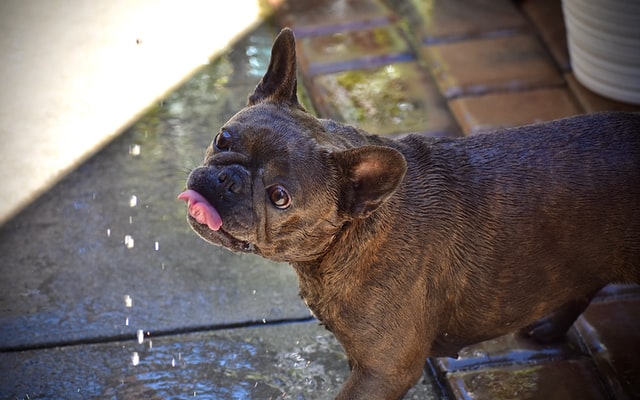
How can you check for dehydration in your dog?
Gently pinch your dog’s skin at the shoulders about an inch from the body, then release it. If the skin elasticity is hydrated, the skin should “snap” right back into its regular place. Your dog is dehydrated if the skin does not respond that way and either remains lifted or slowly sinks back into its original spot.
Check your dog’s gums for capillary refill time (CRT), which is the time it takes to see color return once you press on them. Lift your dog’s lip, checking the gum outline. It should be a healthy, pink color. The gum will change color when you press on it with your finger. Release the pressure, and watch how fast the pink color returns. Hydrated gums will return to their standard color immediately; a dehydrated dog’s gums will take at least three seconds to turn from white to a dull pink.
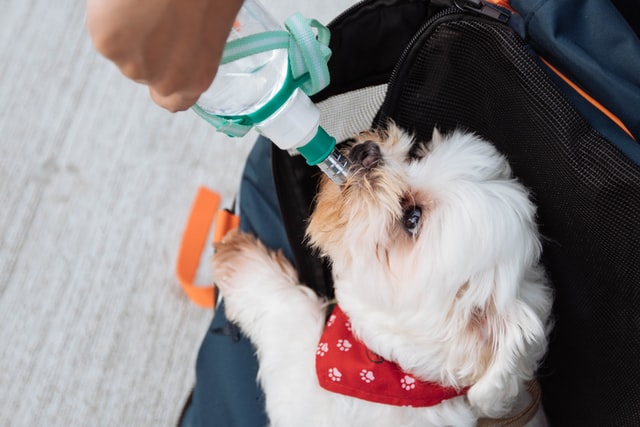
Why is dehydration in dogs dangerous?
Approximately 60% of a dog’s body is water. When that amount becomes too low, it puts your dog’s life in danger. Thus, dehydration in dogs must be taken seriously. Severe dehydration will cause a dog’s organs to function abnormally or even shut down altogether. Once lowered cardiac output and blood flow occur, the dog will require immediate treatment.
The small body mass of puppies makes them more susceptible to dehydration. They have a lot going on in their lives and need plenty of water to keep their energy levels regular. As such, pup parents should ensure that their puppy has access to fresh water and enough fluids.
If you see any signs of shock, heatstroke, or severe dehydration in your dog, it is important to call their veterinarian immediately. They may advise giving them small amounts of water as soon as possible on the way there to begin rehydrating right away. The longer your dog goes without treatment, the more severe the damage is likely to be.
The most important thing you can do for your dog if they are suffering from dehydration is to get them treated immediately with intravenous fluids. Kidney failure or liver failure can be caused by a lack of fluids, so quick treatment is crucial to your dog’s health.

How is canine dehydration treated?
For mild dehydration
The vet may recommend Pedialyte, Ringer’s acetate, or another electrolyte solution in mild cases. Additionally, the vet may suggest you provide your dog with a small amount of water every few minutes or pieces of ice. Be sure to not allow your dog to drink too much water at once; she may vomit, which will further dehydrate her.
For moderate dehydration
Your vet may treat your dog for moderate dehydration with fluid therapy, also known as subcutaneous fluids. The type and amount of fluid will depend upon your dog’s level of dehydration and the veterinarian’s diagnosis. This fluid is absorbed slowly over several hours when given under the skin. It often has a blend of sterile water and dextrose (sugar) with balanced electrolytes.
If your dog is suffering from chronic conditions such as kidney disease, your vet can teach you how to give your pup fluid therapy at home.
For extreme cases
Dogs with diarrhea, frequent vomiting, excessive and panicked panting, and sunken eyes are severely dehydrated and need immediate treatment. Offer the dog a water bowl, but never force her to drink. Take the dog to the veterinarian right away. Treatment will include intravenous fluids and hospitalization.

How can you prevent dehydration in your pup?
The best way to keep your dog hydrated is by providing him with constant clean, clear water. This includes when you take your dog outside or on travels. Some dogs are more thirsty than others, so you may need to make sure they get enough water. Some people flavor their dog’s drinking water with bone broth or give them ice cubes to chew on.
Always keep an eye on your local weather conditions. Hot weather, combined with your dog’s activity level, will influence how much water intake she requires. Generally, dogs need at least one ounce (or 8 grams) of water daily for each pound they weigh. However, this amount can change depending on the environment and activity level.
Make sure to offer your dog enough fluids. They must maintain the right amount, so they stay hydrated. A vet can advise how to best ensure this happens based on your pup’s age and weight.
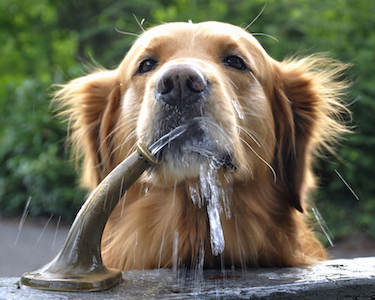
Keep your dog hydrated and safe with pet insurance.
Sometimes it’s hard to recognize the signs of dehydration in dogs until it’s too late. Don’t let emergency treatment for your pet become dependent on what you can afford. With a dog health insurance plan, your pup will receive top-notch care and treatment without you needing to worry about finances. Pet Insurance Review finds pet insurance providers with policies that match your needs. Get a free quote today!
References:
- Jay. (2021). Electrolytes for Dogs. Retrieved from https://breedingbusiness.com/electrolytes-for-dogs/
- AVMA. (2022). Table 5 – Dehydration assessment. Retrieved from https://www.aaha.org/aaha-guidelines/fluid-therapy/quick-reference-fluid-tables/dehydration-assessment/
- PetCoach Editorial. (2022). Capillary Refill Time (CRT) in Dogs & Cats. Retrieved from https://www.petcoach.co/article/capillary-refill-time-crt-in-dogs-cats/
- Thorp, A. (2018), Fluid Calculations: Keeping a Balance. Retrieved from https://todaysveterinarynurse.com/internal-medicine/fluid-calculations-keeping-a-balance/
- Michanowicz, D. (2021). Can Dogs Drink Pedialyte? Retrieved from https://firstvet.com/us/articles/can-dogs-drink-pedialyte
- Kellogg, C. (2020). Ask the Vet Tech: How Much Water Does My Dog Need? Retrieved from https://figopetinsurance.com/blog/ask-vet-tech-how-much-water-does-my-dog-need
The information contained on this blog is intended for informational and educational purposes only and should not be construed as medical advice. It is not a substitute for professional veterinary care. Always consult with your veterinarian before making any changes to your pet's health care or treatment plan.
The authors of this blog are not veterinarians and do not claim to be experts in pet health. The information provided here is based on our own experiences and research, as well as information from reputable sources. However, we cannot guarantee the accuracy or completeness of this information.
We encourage you to do your own research and consult with your veterinarian before making any decisions about your pet's health.
Previous post
Trazodone Side Effects in Dogs: What to Look ForNext post
10 Tips for Caring for Blind PetsCompare top pet insurance providers plans.
Enter your dog’s age in years and months to calculate their age equivalent to human years.
Calculate your dog’s ageEnter your cat’s age in years and months to calculate their age equivalent to human years.
Calculate your cat’s age